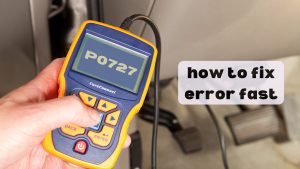When you’re dealing with a P0727 code, it’s important to act quickly to prevent more damage to your vehicle.
First, confirm the error with an OBD2 scanner and check for any other error codes that might show up.
Inspect the engine speed sensor for any signs of damage or dirt—clean it or replace it if needed.
Also, check the wiring for any breaks or corrosion, and make sure all connectors are clean and secure.
But what if the problem still persists?
There are more steps you can take to ensure your vehicle runs smoothly again.

Quick Navigation
Key Takeaways
- Change the bad engine speed sensor to get the right signals again.
- Check and fix or replace any broken or rusty wires and connections.
- Use an OBD2 scanner to find more error codes and help with figuring out the problem.
- Clean the engine speed sensor and the area around it to make sure it works well.
Understanding the P0727 Code
The P0727 code means ‘Engine Speed Input Circuit No Signal.’
This tells you that the ECM (Engine Control Module) isn’t getting a signal from the engine speed sensor. This sensor is important because it tracks how fast the engine is running and sends this information to the ECM. When the ECM doesn’t get this signal, it can’t control the engine properly.
To figure out what’s wrong, use a tool like an OBD2 scanner to look for other error codes.
Check the engine speed sensor with these tools to see if it’s working. This helps you determine if the problem is with the sensor itself, the wiring, or the ECM. Doing a thorough check ensures you fix the right problem quickly.
Symptoms of P0727 Error
If you’re dealing with a P0727 error, you’ll likely notice your car stalling, having poor acceleration, or experiencing shifting problems.
These issues mean there’s something wrong with your engine speed sensor. When your car stalls or hesitates, it’s because the sensor isn’t giving accurate info to the ECM (Engine Control Module). This can make it hard for your car to shift gears smoothly.
To find out if you have this error, you’ll need a diagnostic tool like an OBD2 scanner. This tool will show you if the P0727 code is there and help check the sensor’s performance.
Paying attention to these signs and using diagnostic tools quickly can help prevent more damage and keep your car running smoothly.
Causes of P0727 Code
Common causes of a P0727 code include a bad engine speed sensor, wiring problems, a faulty ECM (Engine Control Module), corroded connections, and environmental factors.
When dealing with this code, consider these potential issues and solutions:
- Bad Engine Speed Sensor: If the sensor isn’t working right, you might need to replace it.
- Wiring Problems: Check and fix any broken or damaged wires.
Corrosion and environmental factors can also affect these parts, so make sure all connections are clean and dry.
Fixing these problems quickly can help you avoid more issues and keep your vehicle running smoothly.
Commonly Affected Vehicles
Many Nissan models, like the Altima, Maxima, and Quest, often face the P0727 code because of problems with their engine speed sensors or the wiring connected to them.
These issues can lead to performance problems, making the cars less reliable. The usual causes are faulty sensors and wiring that has worn out over time.
To keep your car running well, regularly use diagnostic tools to check the electrical systems. It’s important to regularly inspect and replace any worn-out sensors or damaged wiring.
When dealing with the P0727 code, pay close attention to the wiring and the engine speed sensor. Keeping these parts in good condition can prevent more problems and ensure your Nissan runs smoothly.
Checking for Other Codes
Start by checking for other OBD2 codes, as they can give you more clues and help find the main cause of the P0727 code.
Using advanced diagnostic tools, you can get a complete picture of what’s going on with your vehicle. These tools not only read codes but also track sensor performance in real-time, making it easier to diagnose the issue.
Key steps include:
- Look for Related Codes: Finding other codes can help narrow down the problem.
- Check Sensor Data: Monitor how other sensors that work with the engine speed sensor are performing.
Inspecting the Engine Speed Sensor
After checking for other OBD2 codes, the next step is to look at the engine speed sensor using a diagnostic scanner to see if it’s working right.
First, find the sensor, usually located near the crankshaft or camshaft. Hook up the diagnostic scanner and check the signal to make sure the sensor is sending accurate information to the ECM. Watch the live data stream; any odd readings could mean the sensor is faulty.
To keep the sensor in good shape, clean it and the area around it to get rid of any dirt that could mess with its function.
Make sure the sensor is firmly in place and not damaged. If the signal test shows problems or no signal at all, you’ll probably need to replace the sensor to get your engine running smoothly again.
Examining Wiring and Connectors
Check your vehicle’s wiring and connectors for any damage, rust, or loose connections that might mess up the signal from the engine speed sensor to the ECM.
Start by making sure the wiring is in good shape and the connectors are clean, as this is crucial for accurate signal transmission.
Here’s a simple checklist:
- Look for Frayed Wires: Check for any visible wear or breaks in the wiring.
- Clean Connectors: Use contact cleaner to get rid of any rust or dirt from the connectors.
Assessing the ECM
To check the ECM, you’ll need a diagnostic tool to make sure it’s working right and getting signals from the engine speed sensor.
Start by connecting the diagnostic tool to the OBD2 port and look for any error codes.
Testing the ECM means looking at live data to see if it’s correctly reading the engine speed sensor’s input. If your tool shows no signal or weird readings, you might need to think about replacing the ECM.
But before doing that, check all the wiring and connectors since these can cause similar problems.
If everything checks out, go ahead with the ECM replacement, making sure it’s the right one for your vehicle.
This straightforward method can help fix the P0727 code and get your car running smoothly again.
Environmental Factors Impact
Environmental factors like moisture, extreme temperatures, and dirt can negatively affect the engine speed sensor and its connections, which might trigger a P0727 code. These conditions can cause the sensor to fail, leading to poor engine performance. Moisture is especially harmful because it can cause corrosion and short circuits in the sensor’s wiring.
To prevent these problems, consider the following steps:
- Check the sensor and its wiring regularly for signs of dirt and moisture.
- Use protective covers to shield the sensor from harsh weather.
Potential Fixes for P0727
When dealing with a P0727 code, the easiest and most effective fix is usually replacing a bad engine speed sensor. Start by checking the sensor and its connections. If the sensor is damaged, replace it. Also, don’t forget to look at the wiring; damaged or corroded wires can cause this code too. Fix or replace any bad wires you find.
Here’s a quick guide to help you troubleshoot:
| Problem | Possible Fix |
|---|---|
| Bad Speed Sensor | Replace the sensor |
| Damaged Wiring | Fix or replace wires |
| Corroded Connectors | Clean or replace them |
| Faulty ECM | Replace the ECM |
| Environmental Damage | Check and fix issues |
More OBD-II Codes
Frequently Asked Questions
How Much Does It Typically Cost to Repair a P0727 Code?
It usually costs between $150 and $400 to fix a P0727 code. The actual cost will depend on what the problem is. To figure out the best way to fix it, use diagnostic tools to check the engine speed sensor, wiring, and ECM (Engine Control Module).
Can I Drive My Car With a P0727 Code?
Driving your car with a P0727 code is like driving with your eyes closed—it’s risky and unsafe. If you’re experiencing issues like stalling and poor acceleration, you shouldn’t drive until you get it checked out to avoid causing more damage.
How Long Does It Take to Fix a P0727 Code Issue?
Fixing a P0727 code can take a few hours. Use diagnostic tools to find the problem. Follow these steps: check the engine speed sensor, inspect the wiring, and look at the ECM. Acting quickly can prevent more issues.
Are There Any Temporary Solutions for a P0727 Error?
Are you looking for quick fixes for a P0727 error? You can try checking and cleaning the engine speed sensor and its wiring using some diagnostic tools. This might help for a little while, but you’ll still need to get a proper repair done soon.
Will a P0727 Code Affect My Vehicle’s Fuel Efficiency?
Yes, a P0727 code will affect your vehicle’s fuel consumption. When your engine doesn’t perform well because of this code, it uses fuel less efficiently, which means you’ll end up using more gas and your overall fuel efficiency will drop. Fix it as soon as you can.
Conclusion
In short, you can fix the P0727 code quickly by using an OBD2 scanner and checking the engine speed sensor and wiring.
Did you know that faulty sensors cause 30% of engine problems? Make sure all connectors are secure and clean.
If the issue continues, look into the ECM, but don’t replace it without thorough checks.
By following these steps, you’ll resolve the P0727 code fast and keep your vehicle running smoothly.

